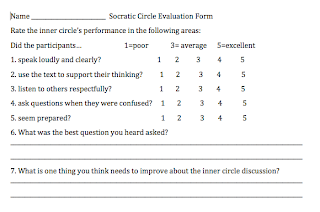This month I started having students write “Slice of Life”
paragraphs, short commentaries on something they’ve done or something they’ve
observed, and then I posted them in the hallways and invited our school staff
and students to make comments on post-it notes. I’ve been very pleased with the
initial response from everyone so far, and I’m excited to continue the project.
I wondered if students might complain about having to write something, but
because they are doing something like this every day in our daily writing, I
haven’t heard anything negative. In fact, it’s been the opposite. Once the
students saw their writing posted, and got a few comments on post-its, they
wanted to write more. Some have three or four writings in their folders, just
waiting for the okay to put another one up. I didn’t want to overwhelm the
readers, so I had the first writings up for three or four days, and then we
just taped the second piece over the top of the first piece, so readers could
keep reading. Every day, students
ask if they can go out and read and make comments on the writing. I’ve had to
monitor that a bit more closely since I can’t have five kids in the hallway
unsupervised, but I’ve encouraged kids to respond in the morning when they have
a bit of time. Other teachers and staff have been kind about reading and
leaving a comment or two as well.
Is
the writing perfect? Not so much. It’s very clear which students need to be
more rigorous in checking spelling and punctuation, and some of them have a
very loose understanding of what a paragraph is, so I’ve tried to address that
as we’ve gone along. But I think as students see what their peers are writing
about, that will encourage them to polish things up a bit.
The
part I think has been the most powerful, though, is reading about how a student
is worried about her dad, who was taken to the hospital that morning, or the
student who is concerned about the neighbors who are fighting. I wouldn’t
normally hear all of those stories, but writing them down allows students to be
heard. Some kids wrote about how they got their dog, or injuries they’ve
received, or a recipe they’ve tried – the topics are all over the board. I
think most people just need someone to listen to them, and if they can’t do it
by talking, then writing allows them to share. For some kids, I think it’s
easier to write things down than to say them out loud. By putting their writing
up on the wall, they have a new audience. And the comments are often very
compassionate, reminding the writers that they aren’t alone with their concerns.
I’m excited to see how these writings evolve over the rest of the year!









